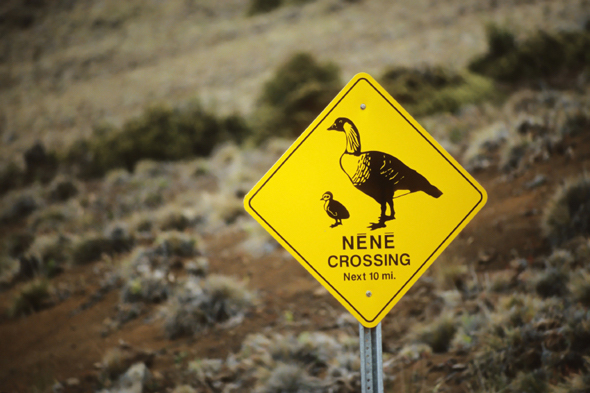GETTING BEAKY WITH HAWAII’S FAVORITE BIRD

We’ve got the gossip on Hawaii’s favorite goose – the Nene (pronounced nay-nay) Goose. Native to the Hawaiian Islands and the official state bird of Hawaii, the name “Nene” refers to the gentle chirp it makes.
Though the Nene spends a majority of its time on land, they do fly – typically between nesting and feeding areas. The Nene Goose has unique markings — a black face and hind neck, with cream-colored cheeks and furrowed neck with black and pale gray stripes. The female goose has very similar markings to its male counterpart, and most people can only distinguish them by their slightly smaller (more feminine) size. In order to help the Nene Goose navigate the rough terrain and lava plains it calls home, its feet are padded with less webbing than the average bird.
The Nene is an herbivore that grazes on available vegetation, preferring leaves, seeds, berries and flowers.
The Nene’s Hawaii Love Nest
Though it was once established on six Hawaiian Islands, today the Nene is found only on Hawaii Island, Maui, Molokai and Kauai. On these islands, the Nene hides out in shrubland, grassland, coastal dunes and most often lava planes.
The Nene Goose’s breeding season runs for nine months from August to April, which is longer than any other goose. Most geese lay their eggs – on average around three a season — between November and January. Female geese are responsible for incubating the eggs while the males stand watch – a period which can take anywhere between 29 to 32 days. Once hatched these independent chickadees are able to forage for themselves but don’t leave the nest until the following breeding season.

Protecting the Nene Population
Historians believe that there were once nine different species of geese that evolved in Hawaii from ancestors including the Canada Goose. All but one of these species became extinct – the remaining goose, the Nene Goose remains under threat of extinction as a result of hunting, egg collecting, and the threat of non-native species like mongooses, cats, pigs, dogs and rats. As a result, the Hawaiian Nene Goose the sixth most endangered waterfowl species and the rarest goose in the world. While historians believe that roughly 25,000 Nene Geese lived in Hawaii before foreigners arrived to the islands in the 1700s, their numbers dwindled to as low as 30 birds in 1952.
Thanks to preservation efforts however, the Nene Goose has bred well in captivity and successfully reintroduced to its natural habitat. Today, there are roughly 800 Nene Goose living in the wild throughout the Hawaiian Islands with around 1,000 birds in collections and zoos around the world.
To help reintroduce the population, the Hawaii Volcanoes National Park launched a captive breeding and reintroduction program sometime in the 1970s. Though their efforts have been hampered by feral cat, mongoose attacks and car accidents, park staff have incorporated a number of new techniques to improve the number of Nene Goose breeding and keep predators from their habitat.
In order to help identify and track the birds to help monitor their numbers and reproduction, park biologists apply leg bands to all Nene birds – both wild and in captivity.
Another Nene Goose rehabilitation program is the Friends of Haleakala National Park program, which is helping to reintroduce the Nene Goose back to Maui. Started in the 1960s, today the program provides a home to roughly 300 geese, with 200 more in West Maui.
For those who would like to learn more about the Haleakala National Park Nene Goose rehabilitation program or to “adopt” a Nene Goose, please visit the Friends of Haleakala National Park. Your donation of $30 or more can help this special species numbers take flight.
